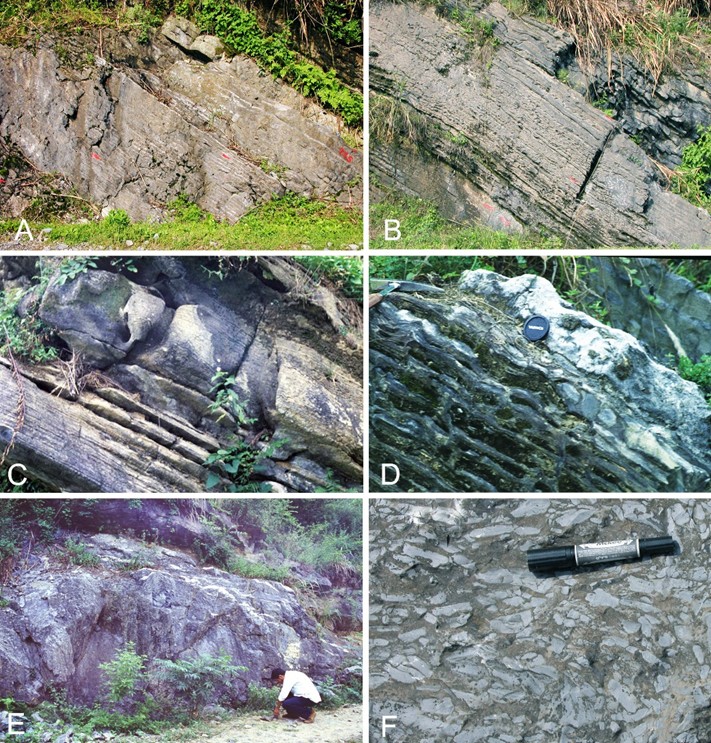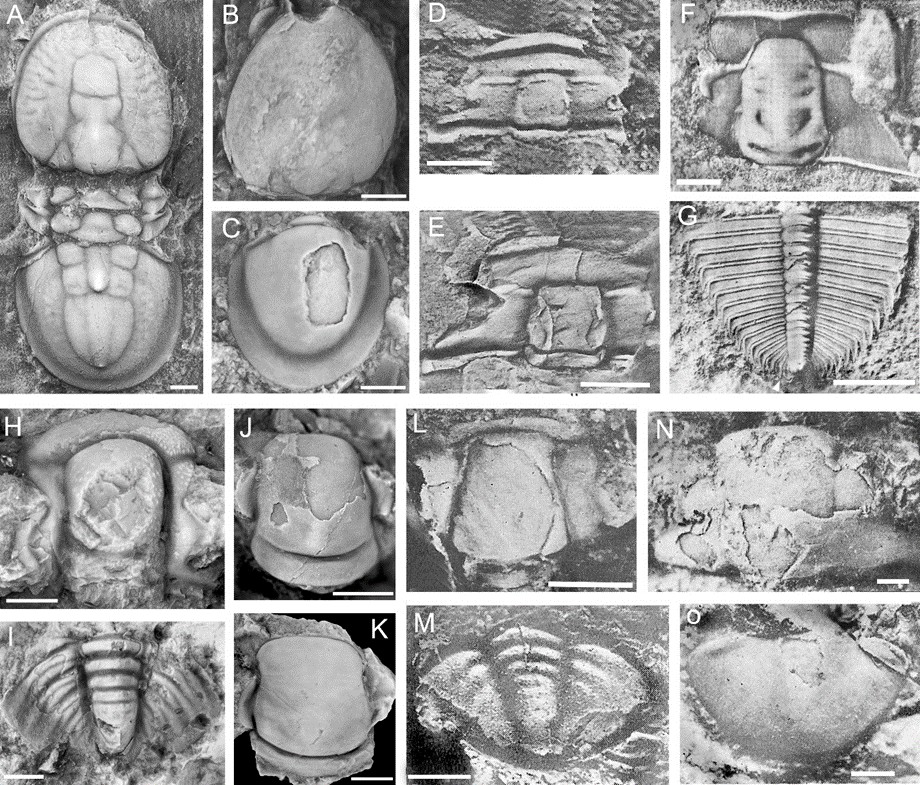Shenjiawan Fm
Type Locality and Naming
The type section of Shenjiawan Formation is the Shenjiawan section, measured between Shanghewan Village in the south and Shenjiawan Village in the north, both villages belong to Cili County. The section lies about 5 km south of the seat of Gaoqiao Township, Cili County, or about 45 km southwest of the seat of Cili County, northwestern Hunan Province, and was remeasured by Peng (1990a). In the type section, the formation is 246.30 m. The Shenjiawan Formation was named by Peng & Tan (1979). The name is derived from Shenjiawan Village in southern Cili County, Zhangjiajie City, northwestern Hunan Province.
Synonym: (沈家湾组); Bitiao Fm (see Additional Information)
Lithology and Thickness
The Shenjiawan Formation is a carbonate sequence. Lower part of the formation is dominated by greyish black and dark grey, thin-bedded laminated limestone and striped argillaceous limestone with several interbeds of light grey, medium and thick-bedded crystalline limestone, occurred at the base and higher levels. Upper part consists of dark grey, medium-bedded limestone, intercalated with laminated argillaceous limestone bearing lenses, argillaceous striped limestone, marlstone, and usually with a single bed of limestone breccia, 2 to 3 m thick, near the top.
[Figure: Outcrops of rock of the Shenjiawan Fm, all from Wa’ergang section, Taoyuan County, northwestern Hunan Province, South China. A, B, thick-bedded argillaceous limestone (about 1.2−1.5 m thick); C, D, thin-bedded argillaceous limestone (below) and median-bedded crystalline limestone (above, about 0.4 and 0.15 m thick respectively); E, F, Super-thick-bedded limestone breccia (3.15 m thick, E) and close-up view (F)]
Relationships and Distribution
Lower contact
The Shenjiawan Fm is in conformable contact with underlying Huaqiao Fm. The lower boundary of the formation is defined by lithological change from the yellow shale, weathered from argillaceous limestone at the top of Huaqiao Fm to the light grey, medium- or thick-bedded crystalline limestone at the base of Shenjiawan Fm
Upper contact
The Shenjiawan Fm is in conformable contact with overlying Panjiazui Fm. The upper boundary is defined by the appearance of shale or siltstone at the base of Panjiazui Fm.
Regional extent
The Shenjiawan Formation is exposed in the Jiangnan Slope Area of South China Region, distributed mainly in northwestern Hunan (Niuchehe and Wa’ergang of Taoyuan County; Shenjiawan of Cili County).
GeoJSON
Fossils
The Shenjiawan Formation is richly fossiliferous with trilobites (polymerids and agnostoids), conodonts, and nautiloids (Peng and Chen, 1983; Peng, 1984, 1992; Dong and Zhang, 2017). Five trilobite zones and five conodont zones are recognized (Peng, 1984, 1992; Dong and Zhang, 2017). These trilobite zones, in ascending order, are: 1, Lotagnostus americanus-Hedinaspis regalis Zone; 2, Leiagnostus cf. bexelli-Archaeuloma taoyuanense Zone; 3, Mictosauki striata-Fatocephalus Zone; and 4, Leiostegium constrictum-Shenjiawania brevis Zone; and the conodont zones are: 1, Proconodontus tenuiserratus Zone (upper part); 2, Proconodontus Zone; 3, Eoconodontus Zone; 4, Cordylodus proavus Zone; and 5, Cordylodus intermedius Zone (lower part). The upper part of the formation yields also nautiloid Plectronoceras sp.
[Figure: Zonal fossils of biostratigraphy of South China, arranged in ascending succession, from left to right and from top to bottom. All are from the Shenjiawan Fm at Shenjiawan, Taoyuan County, northwestern Hunan Province. A, Lotagnostus americanus (Billings, 1860), exoskeleton; B, C; Leiagnostus cf. L. bexelli (Lu and Lin, 1989); D, E, Archaeuloma taoyuanense Peng, 1984; F, G Hedinaspis regalis (Troedsson, 1937), cranidium and incomplete thoracopygon; H, I, Mictosauki striata (Resser and Endo, 1937), cranidium and pygidium; J, K, Fatocephalus hunanensis Peng, 1984, cranidium and cranidium; L, M, Leiostegium constrictum Peng, 1984; N, O, Shenjiawania brevis Peng, 1984. Scale bars = 1 mm for A −C; 2 mm for D−O.]
Age
Depositional setting
The Shenjiawan Formation represents deposits of slope facies.
Additional Information
Lithology and Thickness:
The Shenjiawan Formation is a carbonate sequence. Lower part of the formation is dominated by greyish black and dark grey, thin-bedded laminated limestone and striped argillaceous limestone with several interbeds of light grey, medium and thick-bedded crystalline limestone, occurred at the base and higher levels. Upper part consists of dark grey, medium-bedded limestone, intercalated with laminated argillaceous limestone bearing lenses, argillaceous striped limestone, marlstone, and usually with a single bed of limestone breccia, 2 to 3 m thick, near the top.
[Figure: Outcrops of rock of the Shenjiawan Fm, all from Wa’ergang section, Taoyuan County, northwestern Hunan Province, South China. A, B, thick-bedded argillaceous limestone (about 1.2−1.5 m thick); C, D, thin-bedded argillaceous limestone (below) and median-bedded crystalline limestone (above, about 0.4 and 0.15 m thick respectively); E, F, Super-thick-bedded limestone breccia (3.15 m thick, E) and close-up view (F)]
Lithology-pattern: Limestone
Relationships and Distribution:
Lower contact:
The Shenjiawan Fm is in conformable contact with underlying Huaqiao Fm. The lower boundary of the formation is defined by lithological change from the yellow shale, weathered from argillaceous limestone at the top of Huaqiao Fm to the light grey, medium- or thick-bedded crystalline limestone at the base of Shenjiawan Fm
Upper contact:
The Shenjiawan Fm is in conformable contact with overlying Panjiazui Fm. The upper boundary is defined by the appearance of shale or siltstone at the base of Panjiazui Fm.
Regional extent:
The Shenjiawan Formation is exposed in the Jiangnan Slope Area of South China Region, distributed mainly in northwestern Hunan (Niuchehe and Wa’ergang of Taoyuan County; Shenjiawan of Cili County).
GeoJSON:
Fossils:
The Shenjiawan Formation is richly fossiliferous with trilobites (polymerids and agnostoids), conodonts, and nautiloids (Peng and Chen, 1983; Peng, 1984, 1992; Dong and Zhang, 2017). Five trilobite zones and five conodont zones are recognized (Peng, 1984, 1992; Dong and Zhang, 2017). These trilobite zones, in ascending order, are: 1, Lotagnostus americanus-Hedinaspis regalis Zone; 2, Leiagnostus cf. bexelli-Archaeuloma taoyuanense Zone; 3, Mictosauki striata-Fatocephalus Zone; and 4, Leiostegium constrictum-Shenjiawania brevis Zone; and the conodont zones are: 1, Proconodontus tenuiserratus Zone (upper part); 2, Proconodontus Zone; 3, Eoconodontus Zone; 4, Cordylodus proavus Zone; and 5, Cordylodus intermedius Zone (lower part). The upper part of the formation yields also nautiloid Plectronoceras sp.
[Figure: Zonal fossils of biostratigraphy of South China, arranged in ascending succession, from left to right and from top to bottom. All are from the Shenjiawan Fm at Shenjiawan, Taoyuan County, northwestern Hunan Province. A, Lotagnostus americanus (Billings, 1860), exoskeleton; B, C; Leiagnostus cf. L. bexelli (Lu and Lin, 1989); D, E, Archaeuloma taoyuanense Peng, 1984; F, G Hedinaspis regalis (Troedsson, 1937), cranidium and incomplete thoracopygon; H, I, Mictosauki striata (Resser and Endo, 1937), cranidium and pygidium; J, K, Fatocephalus hunanensis Peng, 1984, cranidium and cranidium; L, M, Leiostegium constrictum Peng, 1984; N, O, Shenjiawania brevis Peng, 1984. Scale bars = 1 mm for A −C; 2 mm for D−O.]
Age:
Late Jiangshanian through early-late Niuchehean.
Age span:
Beginning stage: Jiangshanian
Fraction up in beginning stage: 0.5
Beginning date (Ma):
Ending stage: Cambrian Stage 10
Fraction up in ending stage: 0.85
Ending date (Ma):
Depositional setting:
The Shenjiawan Formation represents deposits of slope facies.
Depositional-pattern:
Additional Information
Zhang (1997) took Bitiao Fm as a valid lithostratigraphic unit by ignoring the formation was erected by paleontological content rather than lithological features. The formation actually is a form of lithostratigraphic unit with biostratigraphic meaning. The Bitiao Fm and both its underlying Chefu Fm and Huaqiao Fm are uniform in lithology, they were erected merely by assemblages of trilobite from a single section (Hunan Regional Geological Survey Team, 1965). Peng and Robison (2000, p. 3) suppressed the names of Chefu and Bitiao formations reassign the Chefu and Bitiao strata to an expanded Huaqiao Fm that holds page priority than two former formations (see entry of Huaqiao Fm). Zhang (1997) lumped the invalid Bitiao Fm with Shenjiawan Fm to form an expended Bitiao Fm. This lump is rejected here. In addition, the assignment of a Cambrian through Ordovician age for his expended Bitiao Fm is also rejected hare. The expanded Bitiao Fm, by including the Shenjiawan Fm, should be only late Cambrian in age as the expended formation underlies immediately the Hysterolenus-bearing basal layer of the Panjiazui Fm. Previously Hysterolenus had been regarded to be an Ordovician (Tremadocian) trilobite but the conodonts associated with the species reveal a latest Cambrian age for the basal part of Panjiazui Fm.

